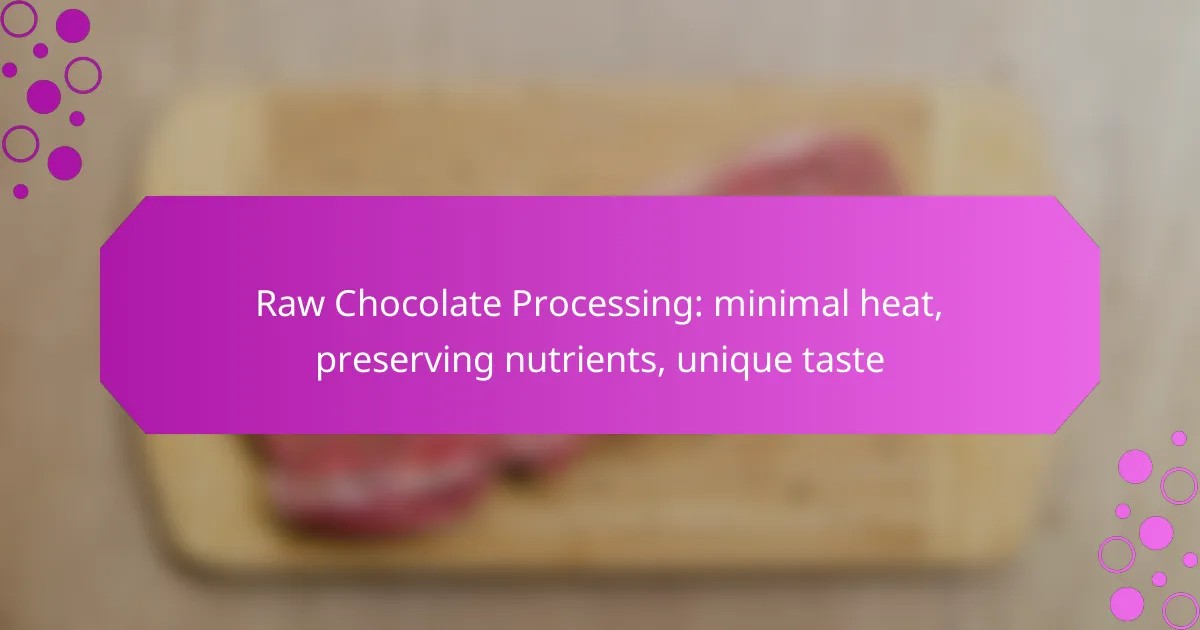Processing raw chocolate with minimal heat is essential for preserving its natural nutrients and unique flavor profile. Techniques such as cold-press extraction and low-temperature roasting ensure that the integrity of the cacao beans is maintained, resulting in a rich taste and numerous health benefits. This careful approach allows chocolate lovers to enjoy a complex flavor experience while reaping the nutritional rewards of antioxidants and minerals found in raw cacao.

How to process raw chocolate with minimal heat?
Processing raw chocolate with minimal heat involves techniques that preserve its natural nutrients and unique flavor profile. Key methods include cold-press extraction, low-temperature roasting, and specific fermentation techniques that maintain the integrity of the cacao beans.
Cold-press extraction
Cold-press extraction is a method that involves mechanically pressing cacao beans at low temperatures to extract cocoa butter and cocoa mass. This process helps retain the delicate flavors and nutritional benefits of the raw chocolate, as it avoids the degradation caused by high heat.
To implement cold-press extraction, use a hydraulic press designed for low-temperature operations. Ensure that the beans are pre-cracked to facilitate the extraction process, and aim for a pressing temperature below 50°C (122°F) to maximize nutrient retention.
Low-temperature roasting
Low-temperature roasting is another effective technique for processing raw chocolate while preserving its nutrients. This method typically involves roasting cacao beans at temperatures ranging from 100°C to 120°C (212°F to 248°F) for a shorter duration compared to traditional roasting.
When using low-temperature roasting, monitor the beans closely to avoid over-roasting, which can lead to a loss of flavor and health benefits. A roasting time of around 20 to 30 minutes is often sufficient, depending on the bean variety and desired flavor profile.
Fermentation techniques
Fermentation is a crucial step in developing the flavor of raw chocolate, and it can be done with minimal heat to preserve the beans’ natural qualities. Typically, cacao beans are fermented in a controlled environment for several days, allowing the natural yeasts and bacteria to enhance their flavor.
To ferment cacao beans effectively, maintain a temperature between 25°C and 35°C (77°F to 95°F) and ensure proper airflow. Cover the beans with banana leaves or similar materials to retain moisture while preventing excessive heat buildup. This approach helps develop complex flavors without compromising the nutritional content.

What are the nutritional benefits of raw chocolate?
Raw chocolate offers numerous nutritional benefits, primarily due to its minimal processing, which helps preserve essential nutrients. It is rich in antioxidants, minerals, and flavonoids, contributing to overall health and well-being.
High antioxidant content
Raw chocolate is packed with antioxidants, particularly flavonoids, which help combat oxidative stress in the body. These compounds can neutralize free radicals, potentially reducing the risk of chronic diseases such as heart disease and cancer.
When selecting raw chocolate, look for products with high cocoa content, ideally above 70%, as they typically contain more antioxidants. Consuming small amounts regularly can enhance your antioxidant intake effectively.
Rich in magnesium
Raw chocolate is an excellent source of magnesium, a vital mineral that supports various bodily functions, including muscle and nerve function, blood sugar control, and bone health. A typical serving can provide a significant portion of the daily recommended intake of magnesium.
Incorporating raw chocolate into your diet can be an enjoyable way to boost magnesium levels. Consider adding it to smoothies, oatmeal, or as a topping for yogurt to enhance both flavor and nutrition.
Source of flavonoids
Flavonoids in raw chocolate contribute to its health benefits, including improved heart health and enhanced cognitive function. These compounds can help lower blood pressure and improve blood flow, promoting cardiovascular health.
To maximize flavonoid intake, choose raw chocolate products that are minimally processed and free from added sugars. Dark chocolate with a high cocoa percentage is typically richer in these beneficial compounds, making it a smart choice for health-conscious consumers.

How does raw chocolate preserve unique flavors?
Raw chocolate preserves unique flavors by maintaining the natural compounds found in cacao beans, which can be diminished through high-heat processing. This approach allows for a richer, more complex taste profile that reflects the bean’s origin and variety.
Flavor profile development
The flavor profile of raw chocolate is developed through careful fermentation and minimal processing techniques. Fermentation enhances the natural sugars and acids in cacao, contributing to fruity, floral, and nutty notes. The absence of high heat ensures that these delicate flavors remain intact, allowing for a more authentic chocolate experience.
Different cacao varieties can yield distinct flavor profiles. For example, Criollo beans are known for their mild, complex flavors, while Forastero beans tend to be more robust and bitter. Understanding these differences can help consumers choose chocolates that align with their taste preferences.
Impact of minimal processing
Minimal processing in raw chocolate involves techniques like cold pressing and low-temperature grinding, which help retain the nutrients and antioxidants present in cacao. This method contrasts sharply with traditional chocolate production, which often involves roasting at high temperatures, leading to a loss of beneficial compounds.
By avoiding high heat, raw chocolate can maintain higher levels of flavonoids and polyphenols, which are linked to various health benefits. Consumers seeking a healthier option may prefer raw chocolate for its potential nutritional advantages, alongside its unique taste.

What equipment is needed for raw chocolate processing?
Raw chocolate processing requires specialized equipment to maintain low temperatures and preserve the nutrients and unique flavors of cacao. Key tools include stone grinders and temperature-controlled dehydrators, which play critical roles in the production process.
Stone grinders
Stone grinders are essential for transforming cacao nibs into a smooth chocolate liquor while keeping the heat low. These grinders use friction to break down the nibs, allowing the natural cocoa butter to emulsify, which is vital for texture and flavor.
When selecting a stone grinder, consider the size and capacity based on your production needs. Smaller models may handle a few kilograms, while larger ones can process tens of kilograms at a time. Ensure the grinder operates at a low temperature to avoid nutrient loss.
Temperature-controlled dehydrators
Temperature-controlled dehydrators are used to dry chocolate products without compromising their nutritional value. Maintaining a consistent low temperature is crucial to prevent the degradation of beneficial compounds found in raw chocolate.
Choose a dehydrator that allows precise temperature settings, ideally below 45°C (113°F). This ensures that the chocolate retains its raw status while achieving the desired texture. Regularly check humidity levels to avoid spoilage and ensure even drying throughout the batch.

What are the best raw chocolate brands in Australia?
Some of the top raw chocolate brands in Australia include Pana Chocolate and Wellness Road, known for their commitment to minimal heat processing and nutrient preservation. These brands offer unique flavors and high-quality ingredients, making them popular choices among health-conscious consumers.
Pana Chocolate
Pana Chocolate is renowned for its organic, raw chocolate products that emphasize minimal processing. They use a cold-press method to retain the natural nutrients and flavors of the cacao beans, resulting in a rich and creamy texture.
The brand offers a variety of flavors, including classic dark chocolate and unique combinations like raspberry and coconut. Pana Chocolate is also vegan and free from refined sugars, appealing to a wide range of dietary preferences.
Wellness Road
Wellness Road focuses on creating raw chocolate that is both delicious and nutritious. Their products are crafted using ethically sourced cacao and are minimally processed to preserve the health benefits of the cacao bean.
With options like raw chocolate bars and cacao nibs, Wellness Road caters to those looking for a guilt-free treat. Their commitment to sustainability and health makes them a standout choice for raw chocolate enthusiasts in Australia.

How to select high-quality raw chocolate?
To select high-quality raw chocolate, prioritize products that emphasize minimal processing and organic sourcing. Look for brands that highlight their commitment to preserving nutrients and unique flavors through careful production methods.
Look for organic certification
Organic certification is a key indicator of high-quality raw chocolate. It ensures that the cacao beans are grown without synthetic pesticides or fertilizers, which can affect both health and flavor. Organic practices often result in richer taste profiles and better nutrient retention.
When shopping for organic raw chocolate, check for certifications from recognized bodies like USDA Organic or EU Organic. These labels confirm adherence to strict agricultural standards, providing assurance of quality and sustainability.
Additionally, consider the source of the cacao. Chocolates made from beans sourced from specific regions known for their unique flavors, such as Ecuador or Madagascar, can offer distinctive taste experiences. Always read labels carefully to ensure you are getting genuine organic products.
